Racing
Finding Target Boat Speed to Windward
Knowing you are going as fast as you can without the use of fancy instruments
By Allen Edwards
Background
Below is the overview page to a series of pages dealing with sailing fast to windward. These articles represent over a year of work on the subject with many on the water trials. The processes below went through many iterations as earlier versions were found to be too complicated to use on the water. I hope you find this useful. Please use the contact form to ask any questions. I am happy to provide guidance with these concepts and any questions will be used to improve the process or its explanation. Thanks, Allen
How do we get to the mark fast?
When sailing toward the windward mark I always wondered, should I point high, or should I fall off a little for more speed. Some boats are blessed with instruments that give them these answers. They know how high to point and how fast to go to get them to the mark quickly. My boat is simple. I have a hand held wind meter, a knot meter, and a masthead fly. How can I know what the best point of sail is?What are we trying to do?
It would be nice if you could point your boat higher and go faster at the same time but it doesn't work that way. Pointing higher makes the boat head more toward the mark but makes it go slower. Fall off and your boat goes faster but it is not heading toward the mark as much so has to sail a longer distance. There is an optimum angle to the wind and corresponding boat speed such that the combination of boat speed and distance travel yields a minimum time. This speed is called the target speed and the angle to the wind the target wind angle. It turns out that by far the best way to sail to the target is to use the target boat speed and sail to that, heading up if you are going faster than this target and falling off if you are too slow. The change in boat speed vs heading is far more sensitive than anything else. If you know your target boat speed, you can sail at that speed knowing you are going to the mark as fast as the boat is capable of. Finding that target speed is what this set of tools is all about.Introduction
These tools assume you have a masthead fly, a knot meter (or GPS if you sail without current) and knowledge of the true wind speed either from a wind meter, or the sea state. Using these tools you will then be able to compare different sail trims and target speeds to find the fastest target speed for the conditions. This process has gone through many iterations over the course of a full year to make it usable without calculators or many pieces of paper. The basic process is to 1) Understand the concept of target speed 2) Calibrate your instruments 3) Take data on the water 4) Analyze the data. 5) Create targets vs wind speed for use during the race. 6) Win more races!Background
Using Target Boat Speed
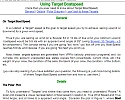 The goal of this exercise is to determine your Target Boat Speed for the conditions you are sailing in with the sail you have up and the crew you have. This is an excellent article on the concept of target boat speed. I recommend you read this article as a first step.
The goal of this exercise is to determine your Target Boat Speed for the conditions you are sailing in with the sail you have up and the crew you have. This is an excellent article on the concept of target boat speed. I recommend you read this article as a first step.
Background
 For some background on the science behind this you can read THIS It is optional and long and I recommend you skip it until you find you have questions or get really into all of this, then skim it to see if your questions are covered. It covers some background on polars, the math of apparent wind, why not use a GPS, a bit on a couple of the technical tools, and a word on accuracy.
For some background on the science behind this you can read THIS It is optional and long and I recommend you skip it until you find you have questions or get really into all of this, then skim it to see if your questions are covered. It covers some background on polars, the math of apparent wind, why not use a GPS, a bit on a couple of the technical tools, and a word on accuracy.
A Few Canned Polars
 HERE are a few polars I pulled off the Internet for some boats. If your boat is listed this would be a great place to start. The problem with using caned polars is that they represent the perfect boat, clean hull, new sails, perfect crew, in other words, not your boat (except for the perfect crew of course). But they are a good place to start and a good benchmark that you can use to judge your performance if you are lucky enough to have your boat listed.
HERE are a few polars I pulled off the Internet for some boats. If your boat is listed this would be a great place to start. The problem with using caned polars is that they represent the perfect boat, clean hull, new sails, perfect crew, in other words, not your boat (except for the perfect crew of course). But they are a good place to start and a good benchmark that you can use to judge your performance if you are lucky enough to have your boat listed.
Calibration
Masthead Fly
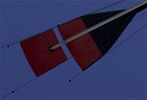 You will need to know something about your masthead fly. HERE is how to calibrate it. It is likely that your masthead fly is close to mine, which is stock. It really doesn't make that much difference. Far more important is the relative changes which you can do without calibrating. It is probably enough to just enter the numbers that the manufacturer gives. But for the most accurate readings here is a method of calibrating the masthead fly from a photograph.
You will need to know something about your masthead fly. HERE is how to calibrate it. It is likely that your masthead fly is close to mine, which is stock. It really doesn't make that much difference. Far more important is the relative changes which you can do without calibrating. It is probably enough to just enter the numbers that the manufacturer gives. But for the most accurate readings here is a method of calibrating the masthead fly from a photograph.
Knot Meter
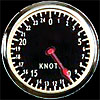 You may also want calibrate your knot meter. Knot Meter Calibration. Again, it isn't super important to be right on. What is important is that you use the same knot meter calibration when you make your measurements as when you sail. A GPS works if you sail with no current.
You may also want calibrate your knot meter. Knot Meter Calibration. Again, it isn't super important to be right on. What is important is that you use the same knot meter calibration when you make your measurements as when you sail. A GPS works if you sail with no current.
Wind Speed
 You will need to know the true wind speed. Some people can get close enough by just looking at the water. I need a meter. My write up shows you how to translate from apparent wind readings to true wind. It isn't difficult.
You will need to know the true wind speed. Some people can get close enough by just looking at the water. I need a meter. My write up shows you how to translate from apparent wind readings to true wind. It isn't difficult.
Data Collection
Data Collection
 Take lots of data. You have to average many readings to see what the boat is doing. The apparent wind angles change quickly and are difficult to read so it takes many readings to get anything useful. In fact, when we take readings out on the water, we are sure that we are just collecting random numbers and that nothing useful will come of it. But when you plot all the data, trends show themselves and it becomes clear what the best boat speed was. Also, remember that the boat reacts slowly to the wind. If the wind is variable, the boat will average it out. Do the same as best you can on your readings of the wind speed and angle. Sail at a constant speed and let the observers average the wind angles and speed over many seconds, hopefully over the same amount of time it takes the boat to react. When you change speeds to get a new point, let the boat settle to a steady state. My boat takes about a minute to get to speed so it takes a couple of minutes to get a point.
Take lots of data. You have to average many readings to see what the boat is doing. The apparent wind angles change quickly and are difficult to read so it takes many readings to get anything useful. In fact, when we take readings out on the water, we are sure that we are just collecting random numbers and that nothing useful will come of it. But when you plot all the data, trends show themselves and it becomes clear what the best boat speed was. Also, remember that the boat reacts slowly to the wind. If the wind is variable, the boat will average it out. Do the same as best you can on your readings of the wind speed and angle. Sail at a constant speed and let the observers average the wind angles and speed over many seconds, hopefully over the same amount of time it takes the boat to react. When you change speeds to get a new point, let the boat settle to a steady state. My boat takes about a minute to get to speed so it takes a couple of minutes to get a point.
Masthead Fly Table
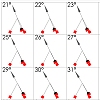 HERE is what different angles look like on your masthead fly. Print this out for reference once you put in your values. It is optional because key masthead fly images are printed out on data chart above but you might find it interesting or useful to see what all the positions look like.
HERE is what different angles look like on your masthead fly. Print this out for reference once you put in your values. It is optional because key masthead fly images are printed out on data chart above but you might find it interesting or useful to see what all the positions look like.
Analyze the Data
Calculator
 This is the Calculator Tool. This is a helpful calculator that converts from apparent to true and visa versa. Provides many calculations Enter what you know and it calculates the rest, shows what the masthead fly will look like and gives you a point on a polar plot.
This is the Calculator Tool. This is a helpful calculator that converts from apparent to true and visa versa. Provides many calculations Enter what you know and it calculates the rest, shows what the masthead fly will look like and gives you a point on a polar plot.
Plot Data
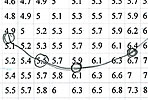 You can use THESE pages to find the target boat speed. I explain them HERE. You can print these out and take them sailing when you are taking data, or use them after you get back on land. Plot your boat speed vs masthead fly position and directly see your fastest point of sail.
You can use THESE pages to find the target boat speed. I explain them HERE. You can print these out and take them sailing when you are taking data, or use them after you get back on land. Plot your boat speed vs masthead fly position and directly see your fastest point of sail.
Curve Fit
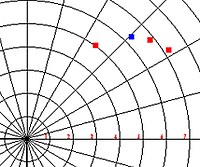 This tool is useful if you have very stable (ie: averaged) observations. You can use this tool to find your target maximum VMG to wind point. It does a curve fit of 3 points and plots the result on a polar plot as well as giving you several calculations.
This tool is useful if you have very stable (ie: averaged) observations. You can use this tool to find your target maximum VMG to wind point. It does a curve fit of 3 points and plots the result on a polar plot as well as giving you several calculations.
Speed and Wind Angle Targets
Boat Speed Target Tool
 The goal is the creation of a chart such as the one at the left that shows the target boat speed for any given true wind speed. This chart also gives the apparent wind speed you would read at that true wind speed so you can actually figure out which boat speed to use. This page will create the table shown to the left. It takes only two target wind speeds to create the table. One at the bottom of your wind range, the other near the top. Even if you don't have any targets, there are ranges of values based on your boat length that can give you a starting point particularly for the next step. Ultimately you will have targets and this chart will be valid for just your boat. This work was based on examining the targets of a wide variety of boats.
The goal is the creation of a chart such as the one at the left that shows the target boat speed for any given true wind speed. This chart also gives the apparent wind speed you would read at that true wind speed so you can actually figure out which boat speed to use. This page will create the table shown to the left. It takes only two target wind speeds to create the table. One at the bottom of your wind range, the other near the top. Even if you don't have any targets, there are ranges of values based on your boat length that can give you a starting point particularly for the next step. Ultimately you will have targets and this chart will be valid for just your boat. This work was based on examining the targets of a wide variety of boats.
Expanded Target Tool
 Once you have the table from the pervious step, you can print the chart shown at the left. This is what you take on the water. This single page allows you to fine tune your target boat speed for the conditions you are racing in. It is also at the same page as the boat speed tool but just select a different "mode" in the form. Instructions on how to use it are HERE.
Once you have the table from the pervious step, you can print the chart shown at the left. This is what you take on the water. This single page allows you to fine tune your target boat speed for the conditions you are racing in. It is also at the same page as the boat speed tool but just select a different "mode" in the form. Instructions on how to use it are HERE.
Target Wind Angle Chart
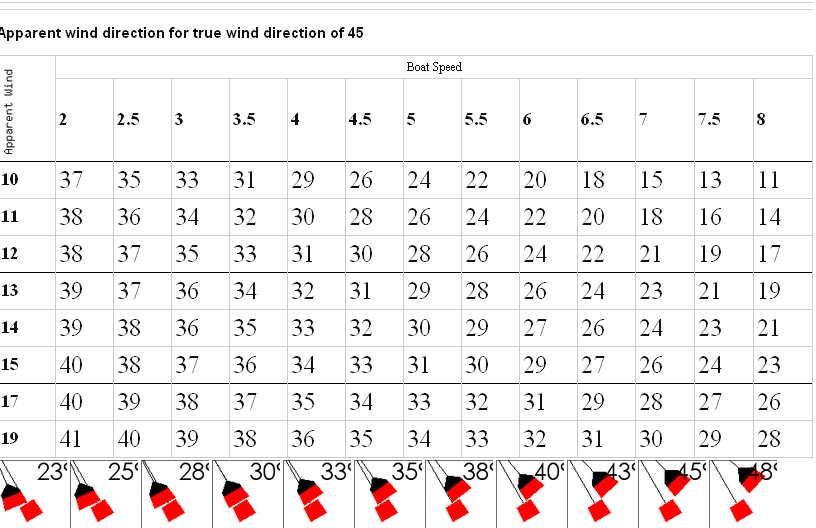 Sailing at a target angle to the true wind is a good place to start This chart allows you to do that. Just head up or fall off until you are matching one of the entries in the chart and you will be going your reference angle to the true wind. The inputs are apparent wind speed and boat speed. The number in the chart is the apparent wind direction you would see if you were at your target angle to the true wind, for example 45 degrees. If you are going too fast, you will be off your target apparent angle. If you are going too slow, you will be pinching compared to your target. Just head up or fall off until you match one of the numbers in the chart, or are between speeds and between headings. Click HERE for details.
Sailing at a target angle to the true wind is a good place to start This chart allows you to do that. Just head up or fall off until you are matching one of the entries in the chart and you will be going your reference angle to the true wind. The inputs are apparent wind speed and boat speed. The number in the chart is the apparent wind direction you would see if you were at your target angle to the true wind, for example 45 degrees. If you are going too fast, you will be off your target apparent angle. If you are going too slow, you will be pinching compared to your target. Just head up or fall off until you match one of the numbers in the chart, or are between speeds and between headings. Click HERE for details.
Win More Races
Good Luck
 That's all folks. Let me know if you find this useful. If it helps you take home the trophy, send me a picture.
That's all folks. Let me know if you find this useful. If it helps you take home the trophy, send me a picture.
NOTICE: Some pages have affiliate links to Amazon. As an Amazon Associate, I earn from qualifying purchases. Please read website Cookie, Privacy, and Disclamers by clicking HERE. To contact me click HERE. For my YouTube page click HERE